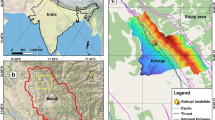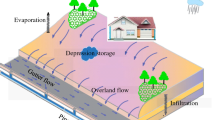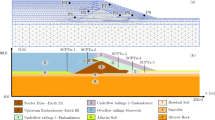Abstract
Submarine landslides can cause severe damage to marine engineering structures. Their sliding velocity and runout distance are two major parameters for quantifying and analyzing the risk of submarine landslides. Currently, commercial calculation programs such as BING have limitations in simulating underwater soil movements. All of these processes can be consistently simulated through a smoothed particle hydrodynamics (SPH) depth integrated model. The basis of the model is a control equation that was developed to take into account the effects of soil consolidation and erosion. In this work, the frictional rheological mode has been used to perform a simulation study of submarine landslides. Time-history curves of the sliding body’s velocity, height, and length under various conditions of water depth, slope gradient, contact friction coefficient, and erosion rate are compared; the maximum sliding distance and velocity are calculated; and patterns of variation are discussed. The findings of this study can provide a reference for disaster warnings and pipeline route selection.
Similar content being viewed by others
References
Arimoto S, Murakami A. 2002. Characteristics of localized behavior of saturated soil by EFG. In: Proceedings of 1st International Workshop on New Frontiers in Computational Geomechanics. Banff: World Scientific, 169–172
Baxter G W, Behringer R P. 1990. Cellular automata models of granular flow. Physical Review A, 42(2): 1017–1020
Blanc T. 2008. Numerical simulation of debris flows with the 2D SPH depth-integrated model [dissertation]. Vienna: University of Natural Resources and Applied Life Sciences
Bruschi R, Bughi S, Spinazzè M, et al. 2006. Impact of debris flows and turbidity currents on seafloor structures. Norwegian Journal of Geology, 86(3): 317–337
Canals M, Lastras G, Urgeles R, et al. 2004. Slope failure dynamics and impacts from seafloor and shallow sub-seafloor geophysical data: case studies from the COSTA project. Marine Geology, 213(1–4): 9–72
De Blasio F V, Engvik L, Harbitz C B, et al. 2004. Hydroplaning and submarine debris flows. Journal of Geophysical Research, 109(C1): C01002
Gauer P, Elverhøi A, Issler D, et al. 2006. On numerical simulations of subaqueous slides: back-calculations of laboratory experiments of clay-rich slides. Norwegian Journal of Geology, 86(3): 295–300
Gue C S. 2012. Submarine landslide flows simulation through centrifuge modelling [dissertation]. Cambridge: University of Cambridge
Hao Minghui, Xu Qiang, Yang Lei, et al. 2014. Physical modeling and movement mechanism of landslide-debris avalanches. Rock and Soil Mechanics (in Chinese), 35(S1): 127–132
Harbitz C B, Parker G, Elverhøi A, et al. 2003. Hydroplaning of subaqueous debris flows and glide blocks: analytical solutions and discussion. Journal of Geophysical Research, 108(B7): 2349
Hu Guanghai. 2011. Identification of submarine landslides along the continental slope of the east china sea and analysis of factors causing submarine landslides (in Chinese) [dissertation]. Qingdao: Ocean University of China
Huang Yu, Hao Liang, Xie Pan, et al. 2009. Numerical simulation of large deformation of soil flow based on SPH method. Chinese Journal of Geotechnical Engineering (in Chinese), 31(10): 1520–1524
Imran J, Harff P, Parker G. 2001. A numerical model of submarine debris flow with graphical user interface. Computers & Geoscience, 27(6): 717–729
Kulikov E A, Rabinovich A B, Thomson R E, et al. 1996. The landslide tsunami of November 3, 1994, Skagway Harbor, Alaska. Journal of Geophysical Research, 101(3): 6609–6615
Li Jiagang, Xiu Zongxiang, Shen Hong, et al. 2012. A review of the studies on submarine mass movement. Coastal Engineering (in Chinese), 31(4): 67–78
Locat J, Lee H J. 2002. Submarine landslides: advances and challenges. Canadian Geotechnical Journal, 39(1): 193–212
McDougall S, Hungr O. 2005. Dynamic modelling of entrainment in rapid landslides. Canadian Geotechnical Journal, 42(5): 1437–1448
Monaghan J J, Gingold R A. 1983. Shock simulation by the particle method SPH. Journal of Computational Physics, 52(2): 374–389
Pastor M, Blanc T, Haddad B, et al. 2014. Application of a SPH depthintegrated model to landslide run-out analysis. Landslides, 11(5): 793–812
Pastor M, Blanc T, Pastor M J. 2009a. A depth-integrated viscoplastic model for dilatant saturated cohesive-frictional fluidized mixtures: application to fast catastrophic landslides. Journal of Non-Newtonian Fluid Mechanics, 158(1–3): 142–153
Pastor M, Haddad B, Sorbino G, et al. 2009b. A depth-integrated, coupled SPH model for flow-like landslides and related phenomena. International Journal for Numerical and Analytical Methods in Geomechanics, 33(2): 143–172
Pastor M, Quecedo M, González E, et al. 2004. A simple approximation to bottom friction for Bingham fluid depth integrated models. Journal of Hydraulic Engineering, 130(2): 149–155
Piper D J W, Cochonat P, Morrison M L. 1999. The sequence of events around the epicenter of the 1929 Grand Banks earthquake: initiation of debris flows and turbidity current inferred from sidescan sonar. Sedimentology, 46(1): 79–97
Pirulli M, Pastor M. 2012. Numerical study on the entrainment of bed material into rapid landslides. Géotechnique, 62(11): 959–972
Sasaki T, Ohnishi Y, Yohinaka R. 1994. Discontinuous deformation analysis and its application to rock mechanics problems. Journal of JSCE, 1994(493): 11–20
Saxov S. 1990. Marine slides-some introductory remarks. Marine Geotechnology, 9: 110–114
Shen Tong, Wang Yunsheng, Wu Longke. 2014. Discrete element simulation analysis of formation mechanism of Xiaonanhai landslide in Chongqing City. Rock and Soil Mechanics (in Chinese), 35(S2): 667–675
Zakeri A, Høeg K, Nadim F. 2009. Submarine debris flow impact on pipelines-Part: numerical analysis. Coastal Engineering, 56(1): 1–10
Zhu Lin. 2013. The study on the characteristics of hazardous geology at the pipeline routing area of Liwan 3–1 gas field in the northern South China Sea (in Chinese) [dissertation]. Qingdao: The First Institute Of Oceanography, State Oceanic Administration
Author information
Authors and Affiliations
Corresponding author
Additional information
Foundation item: The Specialized Research Fund for the Doctoral Program of Higher Education under contract No. 20120041130002; the National Key Project of Science and Technology under contract No. 2011ZX 05056-001-02; the Fundamental Research Funds for the Central Universities under contract No. DUT14ZD220.
Rights and permissions
About this article
Cite this article
Wang, Z., Li, X., Liu, P. et al. Numerical analysis of submarine landslides using a smoothed particle hydrodynamics depth integral model. Acta Oceanol. Sin. 35, 134–140 (2016). https://doi.org/10.1007/s13131-016-0864-3
Received:
Accepted:
Published:
Issue Date:
DOI: https://doi.org/10.1007/s13131-016-0864-3




